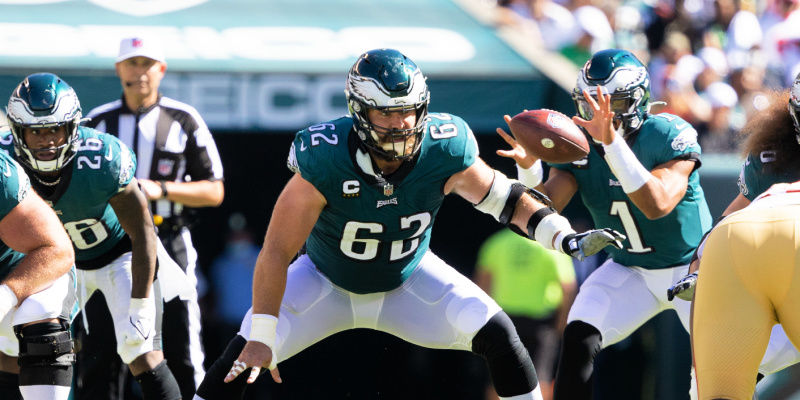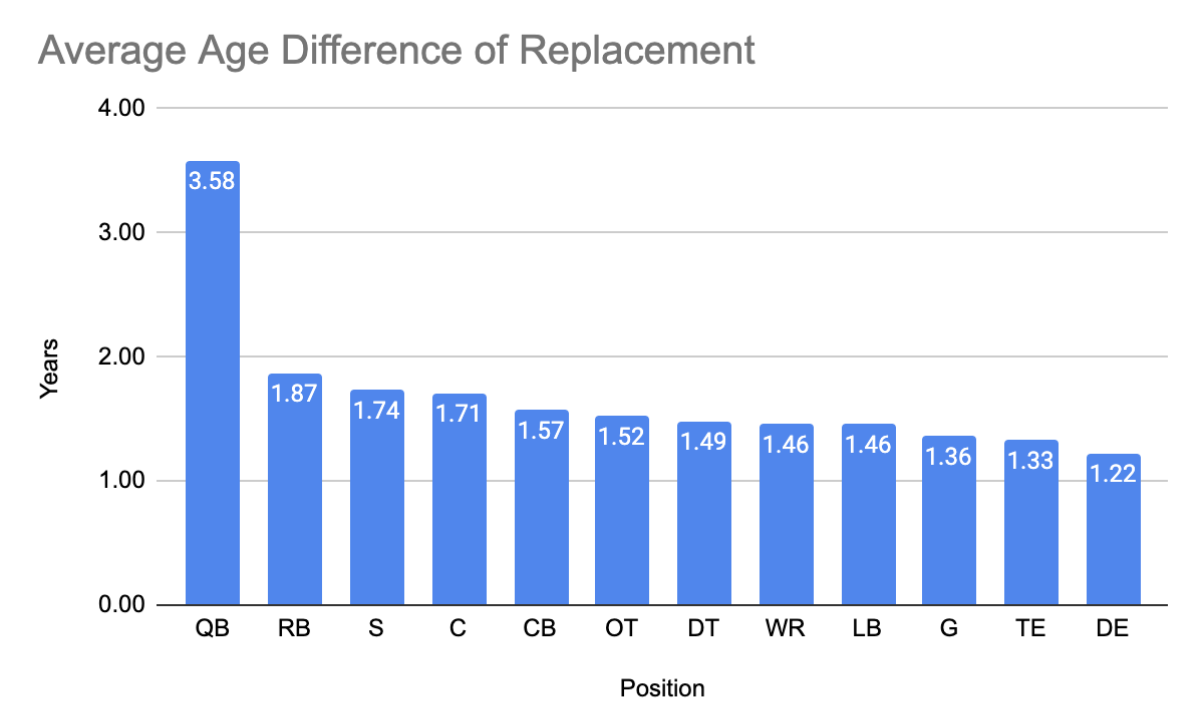Breakdowns
5/18/22
7 min read
Shelf Life Drop Off: How Quickly Players Are Replaced at Every Position

The war on running backs has been raging for quite some time now. The general consensus nowadays is that running backs have a short shelf life, leading to less money and noticeably smaller second contracts compared to other position groups if they get any second contracts at all. Because they are apparently a dime a dozen, it is easy for any team to just drag and drop the next athlete in for little or no difference in output.
The war on running backs is even being waged by players themselves with “wide back” Deebo Samuel apparently having misgivings about his use in the back field with the San Francisco 49ers.
All of this bad publicity towards running backs has us wondering if teams actually replace running backs at free-will as well as if there are any other positions that tend to be replaced more frequently than others?
Which positions appear to have the shortest shelf life?
What data was used?
Team starters were collected from 2015 onwards. 2015 was chosen as a cutoff point in order to keep the data more modern and relevant to today's game trends. The starters' ages were then grouped by team and position. If the starter changed in the following year, the difference in age between both players was recorded. This difference was then used to view how large the drop off in age between positional replacements were.
Let’s call this Shelf Life Drop Off.
Viewing shelf life from the angle of what was the difference in age of starters may provide us the following information:
- How much younger or older do teams tend to replace their starters per position?
- Depending on the size of the drop off in age, how frequently do teams change their starters?
- Does a larger difference in age correlate to a position with longer shelf life?
What did the data expose?
Quarterback is commonly understood to be the position with the greatest longevity. Tom Brady featured interestingly in our analysis by replacing Jameis Winston prior to the 2020 season. It’s not common for a team’s week one starting quarterback to be twenty-five and then be replaced by a forty-three year old the following year. That eighteen year difference is an extreme outlier but for the purpose of the analysis, it was analyzed in the dataset as well as removed to see its impact. Did it greatly affect the final results?

It didn’t drastically impact the results. Quarterback still reigned supreme as the position with the longest shelf life with an average age difference of replacement of 3.5 years.
This means that on average, when teams change their starting quarterback, they tend to go for a replacement that is three and a half years younger. This includes the Brady switch that was a difference of 21.5 years from the average. Brady was eighteen years older than his predecessor whereas teams tend to go for replacements that are three and a half years younger.
When the Brady data point is removed from the calculation, the QB average age difference of replacement (Shelf Life Drop Off) increases to 3.98 years.
Given that it is fair not to normalize anything that Tom Brady contributes to, let's leave here taking the insight that does not include him in our analysis.
From a quarterback perspective, teams on average tend to replace their starting quarterback with one that is four years younger. This is the largest age discrepancy compared to any position, which suggests that quarterbacks get the longest tenure before being replaced, since their replacement tends to be significantly younger. This suggests longevity at the position.
Quarterback having the greatest longevity should not be a surprise at this point. What may surprise some is that most quarterbacks have four years before there is a change. This suggests that they get treated to one contract and must prove worthy of a second contract before it is signed.
Does every player not get one contract to prove their long term worth?
The graph also shows that players tend to get less than one contract to prove their worth — an average shelf life drop off for all other positions falls between one and two years. Think about that for a second. Players barely get two years to prove they have what it takes before they will be replaced. It’s important to note that this data is limited to starters only. For the sake of our data, starting players will get less than two years to stake their claim let alone players that are just trying to make the roster and get whatever reps come their way.
What may surprise many readers is that running back lands second on the list of positions with the biggest drop off in age between replacements. This drop off in age falls just under two years, which means that running backs get replaced by players two years after their start. Although running backs have this current stigma that they only have one valuable contract in their careers, every position appears to be similar and change happens incredibly frequently in the NFL.
In a time post-draft where every fan may feel that they have solved their team's biggest needs for the next ten years, the data suggests that almost every position tends to get replaced often since the age difference between a starter and the player that replaces them is quite small.
If positions had great longevity, then the age difference between the starting player and his replacement would be a lot greater.
Let’s consider Jason Kelce. Kelce recommended that his potential replacement should be Cam Jurgens. Kelce was an incredible sixth round pick by the Philadelphia Eagles in 2011. He turns 35 during the upcoming season while Jurgens turns 23 during training camp. The twelve year drop off represents Kelce’s great longevity.
In a perfect world, this is how the cycle would work. Teams use a pick on a player, and they don’t worry about replacing them for at least a decade. Because of this ideal situation, we should see the average drop offs in age be quite large.
This is in direct contrast to what the data is telling us that every position outside of quarterback has a shelf life drop off between one and two years.
What Does All of This Mean?
Given that the dataset contains the ages of starting players only, this data is representative of the best players in the NFL. Every player’s replacement between 2015 up until now was included, and so the insights only reflect when a team's starters get replaced.
The alarmingly small age difference between players gives little credit to the belief that it tends to only be running backs that have short shelf lives and are easily and frequently replaced. In fact, running backs have the second highest average age difference between a replacement player and their predecessor.
It would be fair to group the positions as quarterback versus the rest given the discrepancy in the difference of age between their replacements.
Players that are successful tend for the most part to have longevity, which means that the age of their replacement will likely be significantly younger than them.
Quarterbacks can expect to get, on average, four years before being replaced if they do not meet expectations. Every other position can expect less than half of that time.The NFL is a win now and ruthless league where results must happen immediately. Whether more patience should be provided to these players is a different topic altogether, but what is clear from these findings is that there is a major sense of urgency to get results immediately.
Anything less than the best will lead to player replacements.
Teams appear to prefer to keep swinging the bat until they hit that home run as the Eagles did with Kelce.








